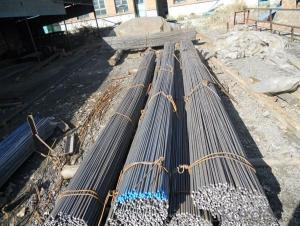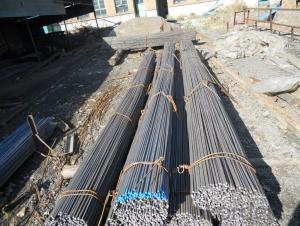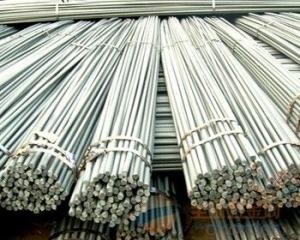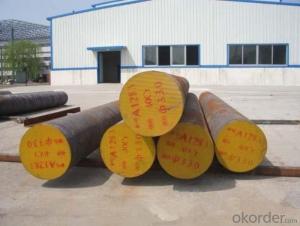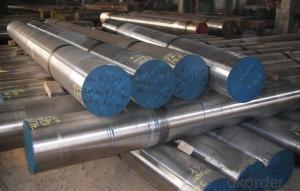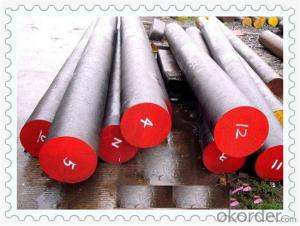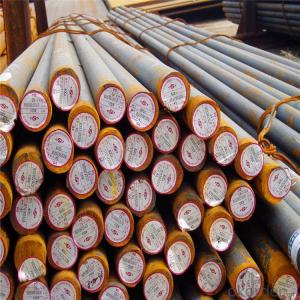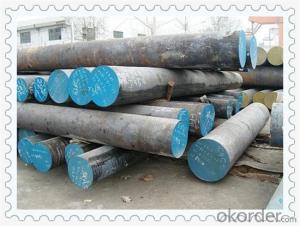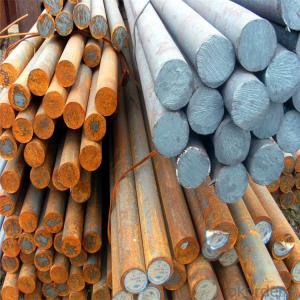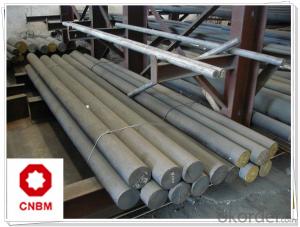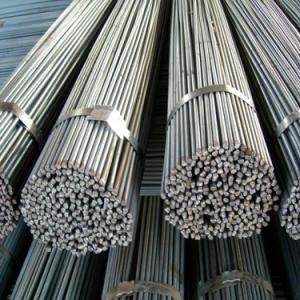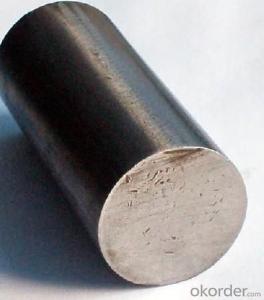IC45 08047 S45C Hot Rolled Carbon Steel Bar with Cr
- Loading Port:
- Tianjin
- Payment Terms:
- TT OR LC
- Min Order Qty:
- 100 m.t.
- Supply Capability:
- 500000 m.t./month
OKorder Service Pledge
OKorder Financial Service
You Might Also Like
Specification
IC45 08047 S45C Hot Rolled Carbon Steel Bar with Cr
Product Description of IC45 08047 S45C Hot Rolled Carbon Steel Bar with Cr
1. Steel grade: ASTM4140, SCM440, 42CrMo, DIN1.7225
2. Length: 6M-12M
3. Diameter: 16mm-300mm
4. Product range: round bar, flat bar, square bar
5. Technique: Hot rolled, forged, cold drawn
Specification of IC45 08047 S45C Hot Rolled Carbon Steel Bar with Cr
Material | SCM4140 | Round bar | Dia(mm) | 16-300mm |
Process | EAF + LF + VD + Forged + Heat Treatment (optional) | Length (mm) | Max 12m | |
Heat treatment | Normalized / Annealed / Quenched / tempered | Flat bar | Thickness(mm) | 8-500mm |
Delivery condition | Hot forged +Rough machined (black surface after Q/T)+ Turned (optional) | Width(mm) | 70-200mm | |
Test | Ultrasonic test according to SEP 1921-84 D/d | Length (mm) | Max 12m |
Chemical Composition of IC45 08047 S45C Hot Rolled Carbon Steel Bar with Cr
C | Si | Mn | Cr | Mo | P | S |
0.38~0.43 | 0.15~0.35 | 0.75~1.00 | 0.8~1.1 | 0.15~0.25 | ≤0.035 | <0.04< td=""> |
Photo Show of IC45 08047 S45C Hot Rolled Carbon Steel Bar with Cr
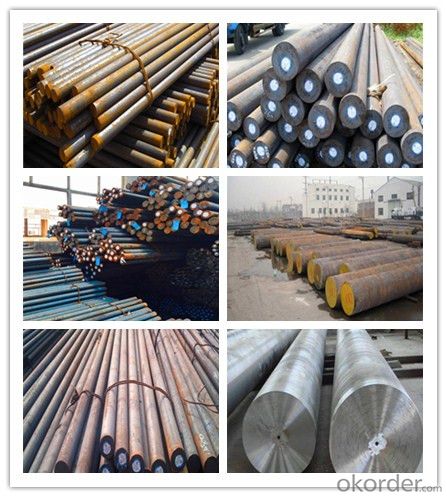
Packing and Delivery:
Packing in bundle package, or as customer's requirements.
Delivery Detail: 45 days after receiving the deposit.
Usage and Applications of IC45 08047 S45C Hot Rolled Carbon Steel Bar with Cr
1. Steel round bar is used in a large number of architectural and engineering structures. Or it can be used in construction of plants for the production of steel house frames, high-voltage transmission towers, bridges, vehicles, boilers, containers, ships, etc.
2. And we can use this kind of product on the performance of the mechanical parts if the demand is not very high.
3. Some special material steel round bar can be used for main shaft of steamer, hummer shank, with big section and supper force.
Company Information
CNBM International Corporation is the most important trading platform of CNBM group.
Whith its advantages, CNBM International are mainly concentrate on Cement, Glass, Iron and Steel, Ceramics industries and devotes herself for supplying high qulity series of refractories as well as technical consultancies and logistics solutions.


F A Q
1, Your advantages?
professional products inquiry, products knowledge train (for agents), smooth goods delivery, excellent customer solution proposale
2, Test & Certificate?
SGS test is available, customer inspection before shipping is welcome, third party inspection is no problem
3, Factory or Trading Company?
CNBM is a trading company but we have so many protocol factories and CNBM works as a trading department of these factories. Also CNBM is the holding company of many factories.
4, Payment Terms?
30% TT as deposit and 70% before delivery.
Irrevocable L/C at sight.
5, Trading Terms?
EXW, FOB, CIF, FFR, CNF
6, After-sale Service?
CNBM provides the services and support you need for every step of our cooperation. We're the business partner you can trust.
For any problem, please kindly contact us at any your convenient time.
We'll reply you in our first priority within 24 hours.
- Q: What are the limitations of steel round bars?
- The limitations of steel round bars include their susceptibility to corrosion, especially in environments with high humidity or exposure to certain chemicals. Additionally, steel round bars may have limitations in terms of their maximum load-bearing capacity, as well as their ability to withstand extreme temperatures. It is also important to consider the potential for steel round bars to deform or bend under excessive stress, which can impact their structural integrity.
- Q: What are the different types of steel round bars used in the automotive drivetrain systems?
- There are several types of steel round bars commonly used in automotive drivetrain systems, including alloy steel, carbon steel, and stainless steel. These bars are chosen based on their specific properties and characteristics, such as strength, durability, and resistance to corrosion. The selection of the type of steel round bar depends on the specific application and requirements of the drivetrain system.
- Q: What is the typical tolerance for diameter and length in steel round bars?
- The tolerance for diameter and length in steel round bars can vary depending on the industry standards and requirements specific to each sector. Generally, the tolerance for diameter in steel round bars is typically between +/- 0.005 and 0.010 inches. This means that the bar's actual diameter can deviate up to 0.010 inches from the specified diameter, either larger or smaller. Likewise, the tolerance for length in steel round bars is usually around +/- 0.125 to 0.250 inches. Consequently, the actual length of the bar can differ up to 0.250 inches from the specified length, either longer or shorter. It is essential to highlight that these tolerances can differ based on the intended application and the manufacturing industry's specific standards. Therefore, it is vital to refer to the relevant industry standards or the manufacturer's specifications to determine the precise tolerances required for a specific steel round bar.
- Q: Are steel round bars suitable for tool-making applications?
- Yes, steel round bars are suitable for tool-making applications. Steel round bars offer several advantages that make them ideal for tool-making. Firstly, steel has excellent strength and durability, allowing tools made from steel round bars to withstand heavy use and resist wear and tear. Steel also has a high hardness, which is crucial for tools that need to cut, drill, or shape materials. Additionally, steel round bars can be easily machined and shaped into various tool designs, providing versatility and customization options. Furthermore, steel has good heat resistance and can withstand high temperatures, making it suitable for tools used in demanding applications such as metalworking or construction. Overall, steel round bars are a popular choice in tool-making due to their strength, durability, versatility, and ability to meet the specific requirements of different tool applications.
- Q: Are steel round bars magnetic?
- Yes, steel round bars can be magnetic. The magnetic properties of steel depend on its composition and processing. Most commonly used steel alloys, such as carbon steel or stainless steel, contain iron as the main component. Iron is a ferromagnetic material, which means it can be magnetized. Therefore, steel round bars made from these alloys will exhibit magnetic properties. However, it is important to note that the strength of the magnetism can vary depending on the specific composition of the steel. Some stainless steel alloys, for example, have a lower magnetic permeability and may exhibit weaker magnetic properties compared to carbon steel.
- Q: What is the difference between a centerless ground and a cold finished steel round bar?
- A centerless ground steel round bar is produced by grinding the surface of the bar to achieve a precise diameter and smooth finish, while a cold finished steel round bar is produced by cold drawing the bar through a die to achieve the desired shape and size without any additional surface treatment. The centerless ground bar has tighter tolerances and a smoother surface, making it suitable for applications that require high precision and a polished appearance. On the other hand, the cold finished bar may have slightly looser tolerances and a rougher surface, but it is more cost-effective and suitable for applications that do not require extreme precision or a polished finish.
- Q: What is the difference between a rough turned and a precision ground steel round bar?
- A rough turned steel round bar refers to a steel bar that has undergone a rough machining process to remove excess material and bring the bar to a closer approximation of its final dimensions. This process typically involves removing the outer layer of the bar through turning or other machining methods. However, the bar is not yet finished to precise tolerances and may still have slight variations in diameter or surface roughness. On the other hand, a precision ground steel round bar has undergone a secondary machining process known as grinding. Grinding is a more precise and controlled method of removing material from the surface of the bar. It involves using a grinding wheel or abrasive tool to carefully remove small amounts of material, resulting in a bar with highly precise dimensions and a smoother surface finish. Precision ground bars are typically made to meet specific tolerances and have a more consistent diameter, surface finish, and straightness compared to rough turned bars. The main difference between a rough turned and a precision ground steel round bar is the level of precision and surface finish achieved. Rough turned bars are suitable for applications where tight tolerances and surface finish are not critical, such as in certain structural or machinery components. Precision ground bars, on the other hand, are preferred when precise dimensions, tight tolerances, and a smooth surface finish are required, such as in precision machining applications or where the bar will be used as a shaft or component in critical machinery or equipment.
- Q: Are steel round bars suitable for construction applications?
- Yes, steel round bars are commonly used in construction applications due to their high strength, durability, and versatility. They are well-suited for structural components such as beams, columns, and reinforcement in concrete structures. Additionally, their availability in various sizes and grades makes them suitable for a wide range of construction projects.
- Q: What are the different surface treatments available for carbon steel round bars?
- Carbon steel round bars have various surface treatments available, each serving a specific purpose and offering unique advantages. Some of the most commonly used treatments include: 1. Galvanizing: A layer of zinc is applied to the surface of the carbon steel round bar. This treatment provides exceptional corrosion resistance and significantly prolongs the steel's lifespan. 2. Black oxide coating: Also called blackening, this treatment creates a uniform, dark finish on the surface of the carbon steel round bar. Black oxide coatings offer mild corrosion resistance, improved lubricity, and a decorative appearance. 3. Chromium plating: By depositing a layer of chromium onto the carbon steel round bar's surface, typically through electroplating, this treatment enhances corrosion resistance, wear resistance, and provides a polished appearance. 4. Nitriding: Nitriding is a heat treatment process that diffuses nitrogen into the surface of the carbon steel round bar, resulting in a hard and wear-resistant layer. This treatment improves the steel's hardness and fatigue strength, making it suitable for applications requiring enhanced durability. 5. Phosphating: Phosphating is a chemical treatment that converts the surface of the carbon steel round bar into a layer of phosphate crystals. This treatment offers excellent corrosion resistance and enhances the adhesion of applied coatings or paints. 6. Powder coating: This treatment involves applying a dry powder to the surface of the carbon steel round bar, which is then cured under heat to form a protective coating. Powder coatings provide exceptional corrosion resistance, durability, and can be customized in various colors and finishes. These examples represent only a few of the available surface treatments for carbon steel round bars. The choice of treatment depends on the specific requirements of the application, such as corrosion resistance, wear resistance, aesthetics, and cost-effectiveness.
- Q: What are the advantages of using nickel-copper alloy steel round bars?
- There are several advantages of using nickel-copper alloy steel round bars. Firstly, these bars offer excellent corrosion resistance, making them ideal for applications in marine environments or industries where exposure to harsh chemicals is common. Secondly, nickel-copper alloy steel round bars possess high strength and durability, ensuring their ability to withstand heavy loads and extreme conditions. Additionally, these bars exhibit excellent heat resistance, making them suitable for high-temperature applications such as in the aerospace or automotive industries. Finally, the nickel-copper alloy steel round bars have good weldability and machinability, allowing for easy fabrication and customization. Overall, these advantages make nickel-copper alloy steel round bars a reliable and versatile choice for various industrial applications.
Send your message to us
IC45 08047 S45C Hot Rolled Carbon Steel Bar with Cr
- Loading Port:
- Tianjin
- Payment Terms:
- TT OR LC
- Min Order Qty:
- 100 m.t.
- Supply Capability:
- 500000 m.t./month
OKorder Service Pledge
OKorder Financial Service
Similar products
Hot products
Hot Searches
Related keywords















